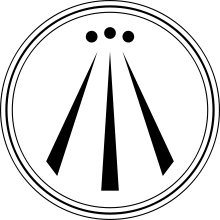Awen
Awen is a Welsh, Cornish and Breton word for "(poetic) inspiration". In the Welsh tradition, awen is the inspiration of the poet bards; or, in its personification, Awen is the inspirational muse of creative artists in general: the inspired individual (often a poet or a soothsayer) is described as an awenydd. Emma Restall Orr, founder and former head of The Druid Network, defines awen as 'flowing spirit' and says that 'Spirit energy in flow is the essence of life'.[1]
In current usage, awen is sometimes ascribed to musicians and poets. It is also occasionally used as a male and female given name.
It appears in the third stanza of Hen Wlad fy Nhadau, the national anthem of Wales.[2]
Etymology
Awen derives from the Indo-European root *-uel, meaning 'to blow', and has the same root as the Welsh word awel meaning 'breeze'.
Historical attestation
The first recorded attestation of the word occurs in Nennius' Historia Brittonum, a Latin text of c. 796, based in part on earlier writings by the Welsh monk, Gildas. It occurs in the phrase 'Tunc talhaern tat aguen in poemate claret' (Talhaern the father of the muse was then renowned in poetry) where the Old Welsh word aguen (awen) occurs in the Latin text describing poets from the sixth century.
It is also recorded in its current form in Canu Llywarch Hen (9th or 10th century?) where Llywarch says 'I know by my awen' indicating it as a source of instinctive knowledge.[3]
On connections between awen as poetic inspiration and as an infusion from the Divine, The Book of Taliesin often implies this. A particularly striking example is contained in the lines:
ban pan doeth peir
ogyrwen awen teir
-literally “the three elements of inspiration that came, splendid, out of the cauldron” but implicitly “that came from God” as ‘peir’ (cauldron) can also mean ‘sovereign’ often with the meaning ‘God’. It is the “three elements” that is cleverly worked in here as awen was sometimes characterised as consisting of three sub-divisions (‘ogyrwen’) so “the ogyrwen of triune inspiration”, perhaps suggesting the Trinity.[4]
Giraldus Cambrensis referred to those inspired by the awen as 'awenyddion' in his Description of Wales (1194):
- THERE are certain persons in Cambria, whom you will find nowhere else, called Awenyddion, or people inspired; when consulted upon any doubtful event, they roar out violently, are rendered beside themselves, and become, as it were, possessed by a spirit. They do not deliver the answer to what is required in a connected manner; but the person who skilfully observes them, will find, after many preambles, and many nugatory and incoherent, though ornamented speeches, the desired explanation conveyed in some turn of a word: they are then roused from their ecstasy, as from a deep sleep, and, as it were, by violence compelled to return to their proper senses. After having answered the questions, they do not recover till violently shaken by other people; nor can they remember the replies they have given. If consulted a second or third time upon the same point, they will make use of expressions totally different; perhaps they speak by the means of fanatic and ignorant spirits. These gifts are usually conferred upon them in dreams: some seem to have sweet milk or honey poured on their lips; others fancy that a written schedule is applied to their mouths and on awaking they publicly declare that they have received this gift.
(Chapter XVI: Concerning the soothsayers of this nation, and persons as it were possessed) [5]
In 1694, the Welsh poet Henry Vaughan wrote to his cousin, the antiquary John Aubrey, in response to a request for some information about the remnants of Druidry in existence in Wales at that time, saying
… the antient Bards … communicated nothing of their knowledge, butt by way of tradition: which I suppose to be the reason that we have no account left nor any sort of remains, or other monuments of their learning of way of living. As to the later Bards, you shall have a most curious Account of them. This vein of poetrie they called Awen, which in their language signifies rapture, or a poetic furore & (in truth) as many of them as I have conversed with are (as I may say) gifted or inspired with it. I was told by a very sober, knowing person (now dead) that in his time, there was a young lad fatherless & motherless, soe very poor that he was forced to beg; butt att last was taken up by a rich man, that kept a great stock of sheep upon the mountains not far from the place where I now dwell who cloathed him & sent him into the mountains to keep his sheep. There in Summer time following the sheep & looking to their lambs, he fell into a deep sleep in which he dreamt, that he saw a beautiful young man with a garland of green leafs upon his head, & an hawk upon his fist: with a quiver full of Arrows att his back, coming towards him (whistling several measures or tunes all the way) att last lett the hawk fly att him, which (he dreamt) gott into his mouth & inward parts, & suddenly awaked in a great fear & consternation: butt possessed with such a vein, or gift of poetrie, that he left the sheep & went about the Countrey, making songs upon all occasions, and came to be the most famous Bard in all the Countrey in his time.
Neo-Druidic Symbol

In some forms of Neo-Druidism the term is symbolized by an emblem showing three straight lines that spread apart as they move downward, drawn within a circle or a series of circles of varying thickness, often with a dot, or point, atop each line. The British Druid Order attributes the symbol to Iolo Morganwg;[7] it has been adopted by some Neo-Druids.

The Order of Bards, Ovates and Druids (OBOD) describe the three lines as rays emanating from three points of light, with those points representing the triple aspect of deity and, also, the points at which the sun rises on the equinoxes and solstices – known as the Triad of the Sunrises. The emblem as used by the OBOD is surrounded by three circles representing the three circles of creation.[8]
Various Neo-Druidic groups and individuals have their own interpretation of the awen. The three lines relate to earth, sea and air; body, mind and spirit; or love, wisdom and truth. It is also said that the awen stands for not simply inspiration, but for inspiration of truth; without awen one cannot proclaim truth. The three foundations of awen are the understanding of truth, the love of truth, and the maintaining of truth.[9]
A version of the awen was approved by the U.S. Veterans Administration in early 2017 for use on veteran headstones.[10]
See also
References
- Emma Restall Orr. Living Druidry. (Piatkus Books, 2004).
- "Welsh National Anthem". Wales website. Welsh Government. 2016. Retrieved 23 October 2016.
- Canu Llywarch Hen ed. Ifor Williams Cardiff, 1935
- Legendary Poems from the Book of Taliesin ed. Marged Haycock CMCS, 2007 p.296
- Gerald of Wales Description of Wales and the Journey Through Wales trans Lewis Thorpe, Penguin, various editions
- "Early Modern Letters Online". Bodleian Library. Retrieved 17 July 2013.
- "Awen - The Holy Spirit of Druidry - The British Druid Order". The British Druid Order.
- Order of Bards, Ovates & Druids (2001). "Approaching The Forest: Gwers 2, Pg. 24". Oak Tree Press.
- J. Williams Ab Ithel, Ed. "The Barddas of Iolo Morganwg, Vol. I"
- Terrence P. Hunt, "Druid symbol approved for use on veteran headstones", The Wild Hunt, January 24, 2017
Kenneth Jackson, Tradition in Early Irish Prophecy, Man, Vol. 34, (May 1934), pp. 67–70.
External links
| Look up awen in Wiktionary, the free dictionary. |